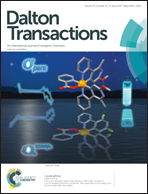Theory, synthesis and reactivity of quintuple bonded complexes
Abstract
This perspective reviews recent advances in the newly discovered metal-to-metal quintuple bonded complexes. The idea of the structures of the metal–metal quintuple bonded complexes was initiated by theoreticians in 1979 and 2001 based on two types of model compounds, the D3h M2L6 and trans-bent M2H2, respectively. This theoretical hypothesis was put into practice in 2005 with the preparation of the first isolable quintuple bonded chromium terphenyl dimer Cr2Ar′2 (Ar′ = 2,6-(2,6-i-Pr2C6H3)2C6H3). After this landmark discovery, many N-based donor-stabilized dinuclear group 6 quintuple bonded complexes with very short metal–metal separations have been identified by X-ray crystallography, and their quintuple bonding was corroborated by magnetic measurements and theoretical calculations. Unlike the quadruple bonded bimetallic units uniformly supported in a tetragonal environment, the configuration of the characterized quintuple bonded dinuclear complexes varies with the ligands and metals. Three types of quintuple bonded complexes have been identified to date. In addition to their geometry variation and interesting bonding schemes, these low-valent and low-coordinate quintuple bonded complexes are highly reducing and have been shown to be reactive towards small inorganic molecules and unsaturated organics.


 Please wait while we load your content...
Please wait while we load your content...